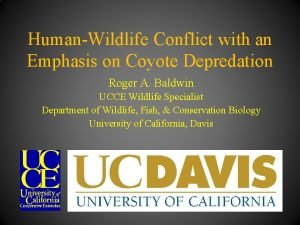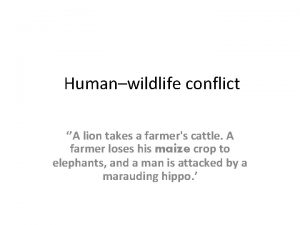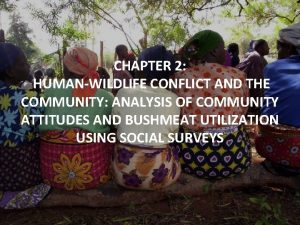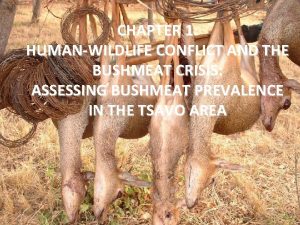THE EFFECTS OF HUMANWILDLIFE CONFLICT ON THE POTENTIAL










- Slides: 10

THE EFFECTS OF HUMAN/WILDLIFE CONFLICT ON THE POTENTIAL FOR COMMUNITY-BASED ECOTOURISM IN THE KASIGAU REGION OF SOUTHEAST KENYA

“The developing world faces many challenges; chief among them is the need to balance ecosystem protection with the advancement of rural community development and food security (Reynolds 2001). ” Community-based ecotourism may be a possible solution and can, if introduced and maintained correctly, achieve this balance by benefiting both local people and wildlife.

Tourism (733 billion USD) Wildlife Tourism Ecotourism Community-based Ecotourism

Community Based Ecotourism Seven Key Aspects (Honey 1999) 1 - Respect local culture 2 - Involve travel to natural areas, 3 - Minimize impact 4 - Build environmental awareness 5 - Provide direct financial benefits for conservation 6 - Provide financial benefits and empowerment for local people 7 - Support human rights and democratic movements

The Potential of Community Based Ecotourism • If rural communities gain resources from CBE they are more likely to protect their environment (Ngece 2002) • CBE allows local people to have more control over ecotourism projects in their area and receive most, if not all of the benefits (Ngece 2002). • New forms of wildlife management, like CBE have begun to lead a recovery in wildlife populations (Emerton 1998)

CBE in the Taita Taveta District: A potential local for increased ecotourism • CBE could be regarded as a tool for sustainable local development in Taita Taveta, Kenya (Himberg 2004) • The Taita Taveta region is the next leader in ecotourism development (Maina 2004) • The development of ecotourism in the Taita Hills is recommended by the Cross-Border Biodiversity Project (Karanja 2002)

Can community-based ecotourism meet these objectives? • Limited information is available “concerning means to assess the success of CBE” (Ross 1999). • Not all sites have the potential for long-term profitability from ecotourism (Isaacs 2000). • Actually achieving benefits for the local community is difficult (Isaacs 2000).

The African Centre for Biodiversity and Conservation Objective: To assist in the development and evaluation of a sustainable, ecologically-sound, wildlife- and ecotourism-based economic model on the community-owned Maungu Ranch Goals: 1) Reduce poaching and subsequent bushmeat utilization 2) Increase a sense of enfranchisement of these communities 3) Produce a model economic system for other rural communities in Kenya

Three Areas of Focus to Reach our Goals: Bushmeat Utilization Community Surveys Wildlife Abundance Is there potential for successful CBE in the Kasigau region of the Taita-Taveta District?

Background on Kenya
 Action potential resting potential
Action potential resting potential Graded potential vs action potential
Graded potential vs action potential Potential due to a point charge
Potential due to a point charge Hypopolarization
Hypopolarization Neuronal pool
Neuronal pool Equipotential lines
Equipotential lines Market potential and forecasting
Market potential and forecasting Graded vs action potential
Graded vs action potential Potential energy of an electric field
Potential energy of an electric field Why is water potential measured in pascals
Why is water potential measured in pascals End plate potential
End plate potential



















